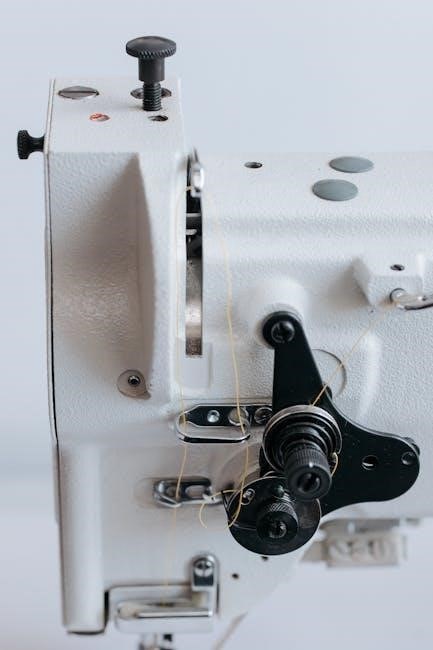
ar 15 operation manual
Welcome to the AR-15 Operation Manual‚ your comprehensive guide to understanding and safely operating the AR-15 rifle. This manual provides detailed instructions on handling‚ maintenance‚ and troubleshooting‚ ensuring safe and effective use of your firearm. Whether you’re a seasoned shooter or a new owner‚ this guide will help you master the AR-15 platform with confidence.
Overview of the AR-15 Rifle
The AR-15 is a lightweight‚ semi-automatic rifle designed by ArmaLite in the 1950s. Originally developed as the AR-15‚ it was later adopted by the U.S. military as the M16. Known for its modular design‚ the AR-15 platform offers versatility‚ allowing users to customize it for various purposes‚ from hunting to tactical applications. Its ergonomic design and reduced recoil make it accessible to a wide range of shooters. The rifle operates using a direct impingement gas system‚ cycling through semi-automatic or burst modes depending on the model. Popular among civilians and law enforcement‚ the AR-15 is celebrated for its durability‚ accuracy‚ and adaptability‚ making it a cornerstone of modern firearms ownership.
Importance of Proper Handling and Safety
Proper handling and safety are paramount when operating the AR-15 rifle. Always treat the firearm as if it is loaded‚ keeping your finger off the trigger until ready to shoot. Ensure the muzzle is pointed in a safe direction‚ away from people and valuables. Wear appropriate eye and ear protection to prevent injury from recoil and noise. Store the firearm unloaded and secured in a safe location‚ inaccessible to children or unauthorized users. Familiarize yourself with local laws and regulations regarding firearm use and storage. Regular training and practice are essential to maintain proficiency and ensure safe operation. Misuse can lead to serious injury or legal consequences‚ making adherence to safety protocols critical for responsible ownership.
Structure and Purpose of the Manual
This manual is organized into clear sections to guide you through the safe and effective use of the AR-15 rifle. It begins with an introduction to the firearm‚ followed by essential safety instructions to ensure responsible handling. Detailed sections cover assembly‚ disassembly‚ and operation‚ providing step-by-step guidance for users of all experience levels. Maintenance and troubleshooting sections help you keep the rifle in optimal condition and address common issues. Customization options and legal considerations are also included to support informed ownership. The manual concludes with final thoughts on safe practices and encouragement for continuous learning. Each section is designed to enhance your understanding and confidence in operating the AR-15‚ making it a vital resource for every owner.

Safety Instructions
SAFETY INSTRUCTIONS are crucial for the responsible use of the AR-15. Always handle the firearm with care‚ ensure it is unloaded when not in use‚ and store it securely. Follow proper loading and firing procedures to prevent accidents. Familiarize yourself with emergency procedures and first aid. If unfamiliar with firearms‚ seek professional training. Adherence to these guidelines is essential for safe operation and legal compliance‚ ensuring the well-being of yourself and others.
General Safety Precautions
Safety is the top priority when handling the AR-15. Always treat the firearm as if it is loaded‚ and never point the muzzle at people or objects you do not intend to shoot. Wear safety glasses and ear protection during use to protect yourself from potential debris and loud noises. Keep your finger off the trigger until you are ready to fire‚ and maintain a firm grip to control the rifle. Avoid handling the firearm when distracted‚ fatigued‚ or under the influence of substances. Store the AR-15 unloaded and secured in a safe location‚ inaccessible to children or unauthorized users. Familiarize yourself with local laws and regulations regarding firearm ownership and use. Always follow proper loading‚ firing‚ and unloading procedures to minimize risks. Regular practice and adherence to these precautions will ensure safe and responsible operation of the AR-15.
Proper Handling and Storage
Proper handling and storage of the AR-15 are crucial for safety and longevity. Always handle the firearm with care‚ ensuring your hands are dry and free from obstructions. When not in use‚ store the AR-15 unloaded‚ with the magazine removed and the action open. Use a high-quality gun safe or lockbox to prevent unauthorized access‚ especially in households with children. Store ammunition separately from the rifle in a cool‚ dry place. Avoid exposing the firearm to extreme temperatures or humidity‚ as this can affect its performance and reliability. Regular cleaning and maintenance will also ensure the rifle remains in optimal condition. By following these storage guidelines‚ you can protect your AR-15 and ensure it remains functional and secure.
Emergency Procedures and First Aid
In case of an emergency‚ remain calm and act swiftly to prevent further harm. If the AR-15 malfunctions or jams‚ immediately stop firing and clear the area. Engage the safety and carefully unload the firearm following proper procedures. For injuries‚ provide immediate first aid‚ such as applying direct pressure to wounds and seeking medical attention. In the event of a gunshot wound‚ call emergency services immediately. Keep a first aid kit accessible and know basic life-saving techniques. Prevent unauthorized access to the firearm during an emergency. Always follow legal and safety guidelines to minimize risks and ensure a safe outcome. Proper training and preparedness are essential for handling emergencies effectively.

Assembly and Disassembly
The AR-15 assembly and disassembly process involves detailed steps‚ requiring identification of key components and proper tools. Follow instructions carefully to ensure correct assembly and safety.
Identifying Key Components of the AR-15
The AR-15 consists of several critical components essential for its operation. The upper receiver houses the barrel‚ bolt carrier group‚ and gas system‚ while the lower receiver contains the trigger group‚ magazine well‚ and buffer tube. The barrel is the heart of the rifle‚ determining accuracy and caliber. The bolt carrier group cycles the action‚ ejecting spent casings and chambering new rounds. The magazine holds ammunition‚ feeding it into the chamber. The pistol grip and stock provide control and stability. Understanding these parts is vital for proper assembly‚ disassembly‚ and maintenance. Always keep the rifle unloaded during inspection to ensure safety.
Step-by-Step Assembly Process
Assembling the AR-15 requires careful attention to detail and adherence to proper procedures. Begin by ensuring all components are clean and free from debris. Attach the upper receiver to the lower receiver by aligning the pivot pin and takedown pin holes‚ then secure them with the takedown pin. Next‚ install the barrel into the upper receiver‚ ensuring it is properly seated and aligned. Tighten the barrel nut using a torque wrench to the manufacturer’s specifications. Install the handguard over the barrel nut‚ ensuring it is securely fastened. Finally‚ attach the stock and pistol grip to the lower receiver. Double-check all connections for tightness and proper alignment before use.
Disassembly for Maintenance and Cleaning
Disassembling the AR-15 for maintenance and cleaning is a straightforward process when done correctly. Begin by removing the magazine and ensuring the firearm is unloaded. Push out the rear takedown pin and separate the upper and lower receivers. Remove the charging handle and bolt carrier group from the upper receiver. Next‚ take out the barrel nut using a torque wrench and carefully pull the barrel forward. Remove the handguard by sliding it off the barrel nut. Finally‚ remove the stock and pistol grip from the lower receiver. For detailed cleaning‚ disassemble the bolt carrier group into the bolt‚ firing pin‚ and extractor. Always follow proper safety protocols and reassemble in the reverse order of disassembly.

Operating the Rifle
Mastering the AR-15 requires understanding its operation‚ from loading to firing. Proper sighting and recoil control ensure accuracy and safety. Always follow safety guidelines for effective use.
Understanding the Semi-Automatic and Burst Modes
Understanding the semi-automatic and burst modes is crucial for safe and effective use of the AR-15. In semi-automatic mode‚ each trigger pull fires one round‚ ideal for precision shooting. Burst mode fires multiple rounds quickly‚ enhancing firepower in controlled situations. Always ensure the muzzle is pointed in a safe direction and use the selector switch deliberately. Proper handling and adherence to safety guidelines are essential to prevent accidents. Familiarize yourself with the specific modes and their functions as detailed in your firearm’s manual for responsible use and optimal performance.
Proper Aiming and Sighting Techniques
Proper aiming and sighting techniques are essential for accurate and effective shooting with the AR-15. Start by aligning the rear sight aperture with the front sight post‚ ensuring the dot or post is centered within the rear peephole. Adjust the sight elevation and windage knobs as needed to zero in your target. Use the front sight tool for precise adjustments. Maintain a consistent cheek weld and eye relief to avoid parallax errors. Practice these techniques at a shooting range to build muscle memory. Always follow safety guidelines and ensure the muzzle is pointed in a safe direction. Proper sighting enhances accuracy and control‚ making you a more confident and skilled shooter.
Recoil Management and Accuracy Tips
Effective recoil management and accuracy techniques are crucial for mastering the AR-15. Start with a proper stance‚ slightly bending the knees to lower your center of gravity. Grip the rifle firmly but not overly tight‚ with your dominant hand controlling the pistol grip and your support hand stabilizing the forearm. Keep your trigger finger relaxed‚ using a smooth‚ consistent pull to avoid jerking the rifle. Focus on your breath‚ exhaling slowly to steady your aim. Aim for consistent follow-through after each shot to maintain target alignment. Proper body positioning and alignment ensure the rifle sits naturally against your shoulder‚ distributing recoil evenly. Practice these techniques regularly to enhance accuracy and control‚ especially during rapid fire. Regular practice improves muscle memory and shooting precision.

Maintenance and Upkeep
Regular maintenance ensures the AR-15’s optimal performance and longevity. Clean the rifle after each use‚ focusing on the barrel‚ bolt carrier group‚ and chamber. Lubricate moving parts with high-quality gun oil to prevent wear. Inspect components like the gas tube and piston for fouling or damage. Proper storage in a dry‚ secure location prevents rust and unauthorized access. Schedule professional inspections if unsure about any aspect of upkeep. Consistent care ensures reliability‚ safety‚ and accuracy.
Cleaning Procedures for the AR-15
Cleaning the AR-15 is essential for maintaining reliability and accuracy. Start by ensuring the rifle is unloaded and the magazine is removed. Use a cleaning rod‚ brush‚ and solvent to scrub the barrel from the chamber end‚ removing fouling and debris. Clean the chamber and bolt carrier group thoroughly‚ paying attention to the gas key and bolt face. Wipe down the upper and lower receivers with a solvent-dampened cloth. Lubricate moving parts‚ such as the bolt carrier and gas tube‚ with a high-quality gun oil to prevent rust and wear. Allow the rifle to dry completely before storage or reuse. Regular cleaning ensures optimal performance and extends the lifespan of your AR-15.
Lubrication of Moving Parts
Lubrication is critical for ensuring the smooth operation of the AR-15. Apply a high-quality gun oil to moving parts‚ such as the bolt carrier group‚ gas tube‚ and pivot points. Use a clean‚ lint-free cloth to wipe down and apply lubricant evenly. Avoid over-lubrication‚ as excess oil can attract debris and impair function. Pay special attention to the bolt face‚ gas key‚ and firing pin‚ as these areas are prone to wear. Re-lubricate after cleaning or exposure to harsh environments. Proper lubrication reduces friction‚ prevents rust‚ and ensures reliable cycling of the action. Regular maintenance helps extend the lifespan of your AR-15 and maintains its performance in various conditions.
Inspecting and Replacing Worn Components
Regular inspection of the AR-15 is essential to identify and replace worn components before they cause malfunctions. Examine the bolt carrier group for excessive wear‚ peening‚ or corrosion. Check the barrel for signs of erosion or excessive fouling. The gas tube and piston should be inspected for damage or carbon buildup. Replace any components that show significant wear. Use only factory-approved or high-quality aftermarket parts to ensure reliability. When replacing parts‚ follow proper torque specifications and alignment guidelines. Keep a maintenance log to track inspections and replacements. Addressing wear promptly prevents potential issues and ensures optimal performance. Always refer to the manufacturer’s guidelines for specific replacement procedures and recommendations.

Troubleshooting Common Issues
- Identify and resolve jamming‚ misfires‚ and feeding problems promptly.
- Inspect for obstructed magazines‚ faulty extractors‚ or worn components.
- Address accuracy issues by checking sight alignment and barrel condition.
- Follow diagnostic steps to ensure reliable operation and safety.

Identifying and Resolving Jamming Problems
Jamming issues with the AR-15 can stem from magazine problems‚ faulty extractors‚ or obstructed chambers. Common jams include failure to feed‚ failure to eject‚ and double feeds. To resolve these‚ clear the chamber safely and inspect the magazine for damage or misalignment. Check the extractor for wear or debris and ensure ammunition is seated properly. Clean the chamber and barrel regularly to prevent residue buildup. If issues persist‚ replace worn components or the magazine. Always maintain a firm grip and keep the muzzle pointed safely during clearing procedures. Preventative maintenance‚ such as lubricating moving parts and using high-quality ammunition‚ can reduce the likelihood of jams. Proper training and familiarity with the rifle’s mechanics are essential for quick and safe resolution.
Addressing Misfires and Feeding Issues
Misfires and feeding issues in the AR-15 can often be traced to ammunition problems‚ magazine malfunctions‚ or improper chamber alignment. Always ensure ammunition is seated correctly in the magazine and free from damage. If a misfire occurs‚ keep the muzzle pointed safely and wait before clearing. Check for obstructions in the chamber or barrel‚ as residue buildup can cause feeding issues. Inspect the magazine for damage or worn springs and replace if necessary. Clean the chamber and bolt carrier group regularly to maintain smooth operation. If feeding problems persist‚ try a different magazine or ammunition type. Lubricate moving parts as outlined in the maintenance section to prevent friction-related issues. Properly addressing these problems ensures reliable performance and safety.
Correcting Accuracy and Sight Alignment Problems
Ensuring proper sight alignment and accuracy is crucial for effective shooting. Start by verifying that your iron sights or optics are securely mounted and properly zeroed. If shots are off-target‚ check the windage and elevation adjustments‚ making incremental changes and testing accuracy after each adjustment. Inspect the barrel for obstructions or damage‚ as this can affect bullet trajectory. Clean the barrel regularly to remove residue that may alter accuracy. If using optics‚ ensure the scope is properly mounted and aligned with the barrel. For persistent issues‚ consider using a laser bore sight to confirm alignment. Always practice proper shooting technique‚ as shooter error can also impact accuracy. Regular maintenance and inspection of sighting systems are essential for reliable performance.

Customization and Accessories
Customize your AR-15 with aftermarket parts‚ including handguards‚ scopes‚ and tactical accessories‚ to enhance performance and personal preference. Upgrade triggers‚ barrels‚ and stocks for improved functionality and ergonomics.
Upgrading the Rifle with Aftermarket Parts
Upgrading your AR-15 with aftermarket parts enhances performance‚ ergonomics‚ and personalization. Popular upgrades include triggers‚ handguards‚ barrels‚ and stocks. Lightweight barrels improve accuracy‚ while free-float handguards provide better grip options. Aftermarket triggers reduce pull weight for smoother firing. Stocks and pistol grips can be customized for comfort. Scopes‚ red dot sights‚ and magnifiers improve targeting. Ensure compatibility with your rifle’s configuration and follow installation instructions carefully. Research reputable brands like FosTecH or Radical Firearms for reliable components. Proper installation is crucial for functionality and safety. Always test upgrades post-installation to ensure optimal performance. Upgrading allows you to tailor your AR-15 to specific needs‚ whether for tactical‚ competitive‚ or recreational use.
Installing Optics and Scopes
Installing optics and scopes on your AR-15 enhances accuracy and target acquisition. Choose optics that match your shooting style‚ such as red dot sights for close-range or magnified scopes for long-range precision. Begin by ensuring the rifle is unloaded. Mount the optic to the Picatinny rail using a sturdy mount‚ tightening screws evenly. Use a torque wrench to avoid over-tightening. Align the optic with the rifle’s bore using a boresight or laser alignment tool. Zero the optic at a shooting range‚ starting with large targets to adjust windage and elevation knobs. Secure all components and test reliability. Proper installation ensures consistent performance‚ making your AR-15 more versatile for various shooting scenarios‚ from tactical to competitive environments.
Adding Tactical Accessories for Enhanced Performance
Enhance your AR-15’s functionality by adding tactical accessories tailored to your needs. A handguard with Picatinny rails allows mounting lights‚ lasers‚ and grips for improved control. Optics like scopes or red dot sights boost accuracy‚ while a sling provides easy carry. Muzzle devices‚ such as compensators or suppressors‚ aid in recoil management. Magazine pouches and plate carriers streamline reloads. Flashlights and lasers improve low-light targeting. Each accessory should be installed securely‚ following manufacturer guidelines. Balance functionality with portability to avoid overloading the rifle. Experiment with configurations to find the optimal setup for your shooting style. Always ensure accessories are compatible and installed correctly for reliable performance. Properly integrated‚ these enhancements elevate your AR-15’s versatility and effectiveness in tactical scenarios.

Legal and Responsible Ownership
Understand and comply with local and federal firearm laws‚ ensuring proper registration and secure storage. Always handle the AR-15 responsibly‚ adhering to ethical use and safety standards.
Understanding Local and Federal Laws
Complying with local and federal firearm laws is crucial for responsible AR-15 ownership. Federal regulations govern the purchase‚ registration‚ and interstate transport of firearms. Local laws may impose additional restrictions‚ such as specific storage requirements or permits. Familiarize yourself with the National Firearms Act (NFA) and the Gun Control Act (GCA) to ensure adherence to legal standards. Always verify state-specific rules‚ as they vary significantly. Proper registration and secure storage are essential to prevent unauthorized access. Transporting the AR-15 legally requires following guidelines on casing and declaring firearms. Failure to comply can result in severe penalties. Consult legal experts or local authorities to ensure full understanding and compliance with all applicable laws.
Responsible Use and Storage of the Firearm
Responsible use and storage of the AR-15 are critical for safety and legal compliance. Always store the firearm unloaded‚ with the bolt open‚ and in a secure‚ locked container. Use a high-quality gun safe or lockbox to prevent unauthorized access‚ especially in homes with children. Employ trigger locks for added security. Store ammunition separately from the rifle to minimize risks. When transporting‚ use a rigid‚ locked case and declare the firearm when required by law. Never leave the AR-15 unattended or accessible to others. Follow all federal and local storage regulations to ensure compliance and safety. Regularly inspect storage systems to maintain their integrity and effectiveness in securing the firearm. Proper storage is a cornerstone of responsible ownership‚ protecting both people and property from potential harm.
Transporting the Rifle Safely and Legally
Transporting the AR-15 requires strict adherence to safety and legal guidelines. Always unload the rifle before transport‚ ensuring no ammunition is present. Use a rigid‚ locked case specifically designed for firearms to prevent unauthorized access. Secure the case in your vehicle to avoid movement during transit. Declare the firearm when required‚ such as during airline travel‚ and comply with all applicable laws. Avoid transporting the AR-15 in visible or accessible locations to minimize risks. Familiarize yourself with local‚ state‚ and federal regulations regarding firearm transportation to ensure compliance. Never leave the rifle unattended during transport‚ as this could lead to theft or misuse. Safe and legal transportation is essential for responsible firearm ownership and public safety.
Final Thoughts on Safe and Effective Use
Safe and effective use of the AR-15 requires a combination of knowledge‚ responsibility‚ and practice. Always handle the firearm with care‚ ensuring muzzle awareness and proper trigger control. Regular maintenance and inspections are crucial to prevent malfunctions and ensure reliability. Familiarize yourself with local laws and regulations to maintain legal compliance. Engage in continuous learning through training courses and hands-on experience to enhance your skills. Remember‚ firearm ownership is a significant responsibility‚ and adhering to safety guidelines is paramount to protecting yourself and others. By following the principles outlined in this manual‚ you can confidently and responsibly operate your AR-15.
Encouragement for Continuous Learning

Continuous learning is essential for mastering the AR-15 platform. Stay updated on new techniques‚ accessories‚ and legal requirements by engaging with educational resources. Participate in firearms training courses‚ online forums‚ and workshops to enhance your skills and knowledge. Regularly review this manual and seek additional guides or videos for a deeper understanding. Learning is a lifelong process‚ and staying informed will improve your proficiency and safety. By committing to continuous learning‚ you’ll become a more responsible and confident AR-15 owner. Remember‚ knowledge is key to safe and effective firearm use.
Importance of Regular Maintenance and Practice
Regular maintenance and practice are critical for ensuring the AR-15 functions reliably and accurately. Proper cleaning and lubrication prevent malfunctions‚ while consistent practice improves accuracy and muscle memory. Schedule routine inspections and follow the manual’s guidelines for disassembly and cleaning. Engage in regular target shooting to maintain proficiency and identify areas for improvement. A well-maintained rifle and disciplined practice routine ensure safety and performance. By prioritizing these habits‚ you’ll extend the lifespan of your AR-15 and enhance your shooting skills‚ fostering confidence and responsibility as a firearm owner.